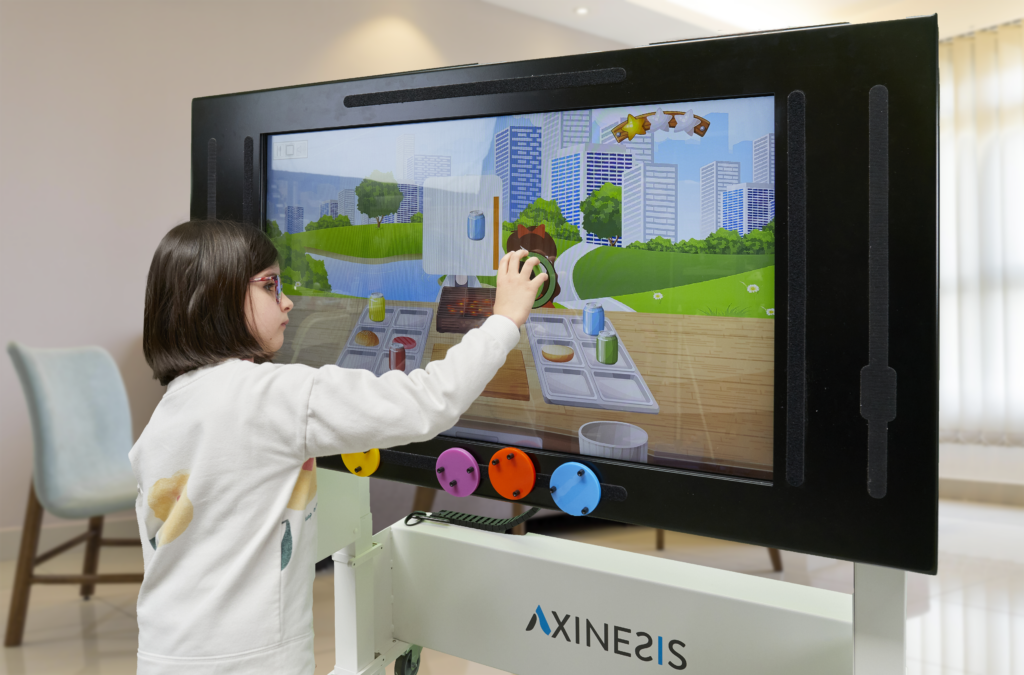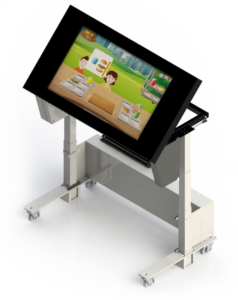We are pleased to announce the publication of a randomised controlled trial evaluating the effectiveness of an intensive and functional HABIT-ILE (Hand and Arm Bimanual Intensive Therapy Including Lower Extremities) camp including sessions with the REAtouch®. This study showed non-inferiority of changes in the upper extremities for children with unilateral cerebral palsy, in comparison with a usual HABIT-ILE intensive intervention, without REAtouch® based sessions(1). The full text published in the Journal of NeuroEngineering and Rehabilitation is available here.

What are REAtouch® and HABIT-ILE ?
REAtouch® is an interactive electro-medical device designed to assist therapists in the rehabilitation and assessment of the upper limb of brain injured patients. This device allows the repetition of functional uni- and bi-manual movements using serious games in interaction with real objects. The development of the REAtouch® is based on a collaboration between Axinesis and the Intensive Rehabilitation Foundation (IRF). This collaboration started with the observation that virtual devices designed for rehabilitation had not been developed to enable clinicians to apply the evidence-based motor skill learning principles. The aim of this collaboration was to develop a virtual device designed to promote the application of evidence-based interventions in the routine care of patients with cerebral palsy and stroke. As a result, the REAtouch® helps therapists to structure their intervention and apply interventions based on motor skills training (e.g. HABIT-ILE).
HABIT-ILE is an evidence-based motor function intervention focusing on bimanual coordination, postural control, and stimulation of the lower extremities. Developed by Pr. Yannick Bleyenheuft and her team(2), its efficacy has been demonstrated in children with cerebral palsy(3–6) and is currently under investigation for stroke adults(7). Delivered in the form of intensive camps (50h-90h of rehabilitation in two weeks), HABIT-ILE intervention aims to reach functional goals, determined by patients themselves, through the training of motor and functional abilities of the upper/lower-extremities and trunk control.
Combining HABIT-ILE and the REAtouch®?
The collaboration between Axinesis and the research team of Pr. Yannick Bleyenheuft (MSL-IN lab, UCLouvain) led to a randomized controlled trial designed to test (1) the effectiveness of implementing the REAtouch® device during a HABIT-ILE intervention, and (2) the opportunity for therapists to apply motor skill learning principles during REAtouch® based sessions(1). For this study, 40 children with unilateral cerebral palsy were randomly assigned to the REAtouch® experimental group (40% of therapeutic time with therapist using the REAtouch®) or to a control group (HABIT-ILE without REAtouch®) for a 90-hour HABIT-ILE intervention (2 weeks). The authors found significant improvements in both groups for most outcome measures (p < 0.05). The children in the REAtouch® group showed non-inferior changes in comparison with the HABIT-ILE intervention without REAtouch®, in terms of upper limb motor abilities, transfer to daily life activities

and achievement of functional goals. In contrast, fewer changes were observed in the REAtouch® group for lower extremities motor function (likely due to the difficulty of implementing challenging activities for the lower extremities during REAtouch® based sessions).
Finally, in this high-level evidence study, the authors argued that the principles of motor skill learning required for HABIT-ILE can be applied during REAtouch®-based sessions. They also recommend customised training for clinicians using REAtouch® as a rehabilitation device to ensure the effectiveness of treatment and the proper use of REAtouch® based on evidence-based recommendations.
These encouraging results led to the creation of a consortium involving Axinesis, Arsalis, UCLouvain and HELHa. The aim of this consortium is to develop a tele-rehabilitation solution combining REAtouch® Lite and the HABIT-ILE method. This solution aims to offer intensive and functional rehabilitation, as well as an assessment protocol, directly at home to brain-injured patients. Initial results have shown that it is feasible to combine the REAtouch® Lite with the HABIT-ILE method at home to rehabilitate adults and children with brain injuries(8). Two randomised controlled trials evaluating the efficacy and cost-effectiveness of these protocols in adults and children were started during summer 2023 (Clinical trials: NCT05740605 and NCT05727111).
To conclude
This randomized controlled trial showed that the REAtouch® might be an interesting supporting device for clinicians who desire to apply the principles of HABIT-ILE for motor function rehabilitation (i.e. therapeutic principles of motor skill learning).
The Axinesis ambition is that any therapy complying with neuro-rehabilitation recommendations, including the principles of motor learning, can be optimized through the use of the REAtouch® device.
|
1. Saussez G, Bailly R, Araneda R, Paradis J, Ebner-Karestinos D, Klöcker A, et al. Efficacy of integrating a semi-immersive virtual device in the HABIT-ILE intervention for children with unilateral cerebral palsy: a non-inferiority randomized controlled trial. J NeuroEngineering Rehabil. 2023;20(1):98. 2. Bleyenheuft Y, Gordon AM. Hand-Arm Bimanual Intensive Therapy Including Lower Extremities (HABIT-ILE) for Children with Cerebral Palsy. Phys Occup Ther Pediatr. nov 2014;34(4):390‑403. 3. Araneda R, Klöcker A, Ebner-Karestinos D, Sogbossi ES, Renders A, Saussez G, et al. Feasibility and effectiveness of HABIT-ILE in children aged 1 to 4 years with cerebral palsy: A pilot study. Ann Phys Rehabil Med. 2021;64(3). 4. Araneda R, Ebner-Karestinos D, Paradis J, Klöcker A, Saussez G, Demas J, et al. Changes Induced by Early Hand-Arm Bimanual Intensive Therapy Including Lower Extremities in Young Children With Unilateral Cerebral Palsy: A Randomized Clinical Trial JAMA Pediatr. 2024 Jan 1;178(1):19-28. doi: 10.1001/jamapediatrics.2023.4809. 5. Bleyenheuft Y, Arnould C, Brandao MB, Bleyenheuft C, Gordon AM. Hand and Arm Bimanual Intensive Therapy Including Lower Extremity (HABIT-ILE) in Children With Unilateral Spastic Cerebral Palsy: A Randomized Trial. Neurorehabil Neural Repair. 2015;29(7):645‑57. 6. Bleyenheuft Y, Ebner-Karestinos D, Surana B, Paradis J, Sidiropoulos A, Renders A, et al. Intensive upper- and lower-extremity training for children with bilateral cerebral palsy: a quasi-randomized trial. Dev Med Child Neurol. 2017;59(6):625‑33. 7. Ebner-Karestinos D, Gathy E, Carton De Tournai A, Herman E, Araneda R, Dricot L, et al. Hand-Arm Bimanual Intensive Therapy Including Lower Extremities (HABIT-ILE) in adults with chronic stroke: protocol of a randomised controlled trial. BMJ Open. 2023;13(4):e070642. 8. Rosseli Z, et al. HABIT-ILE@home for children with cerebral palsy and adults with stroke : a pilot study. 2022; Congress of Tech to Rehabilitation, University of Hasselt. |